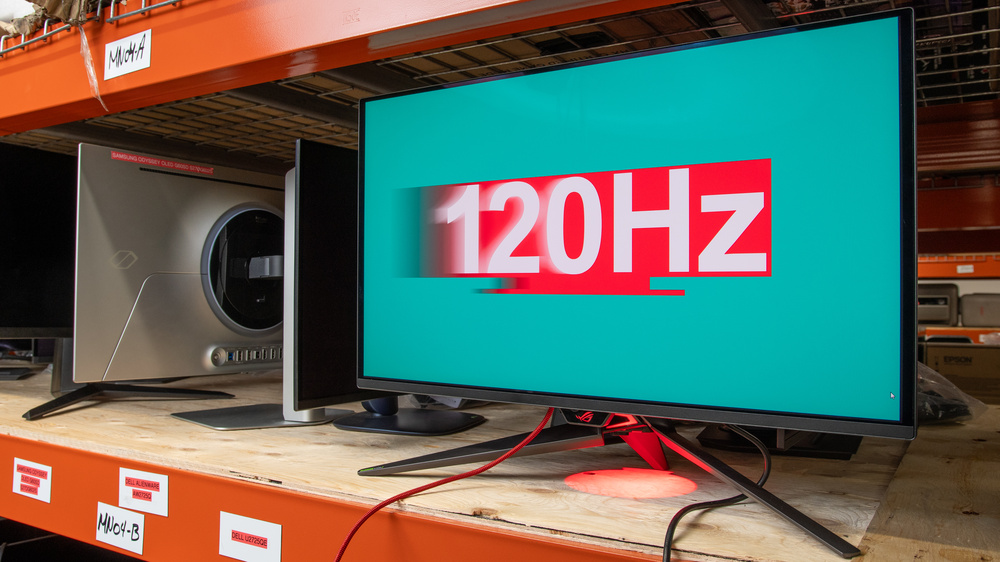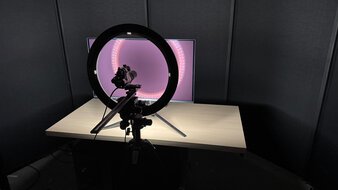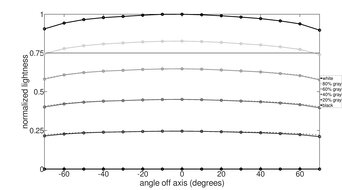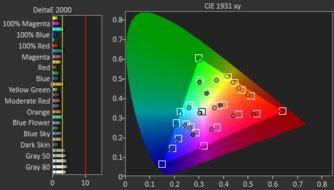Although many gaming monitors and PCs support refresh rates higher than 120Hz, this is the max refresh rate that modern gaming consoles, like the PS5, PS5 Pro, Xbox Series X|S, and Nintendo Switch 2, support. This means if you want to game with a console, you need a monitor that performs well at 120Hz. Monitors with a 4k resolution and HDMI 2.1 bandwidth can take full advantage of these gaming consoles, but you can also consider a lower-resolution display if you want to save some money. Getting a monitor is also a good alternative to getting a TV, as they tend to cost less, are smaller, and are also versatile if you need one for other uses, like productivity or even PC gaming at higher refresh rates.
There are different factors to consider when looking for a monitor for gaming at 120Hz. Firstly, you'll want something with a fast response time at 120Hz so that motion looks crisp. Low input lag and VRR support are also important for a good gaming experience, though most monitors have low input lag and support all common VRR formats. A display with good HDR picture quality also contributes to a great gaming experience with vibrant colors, deep blacks, and highlights that pop.
We've bought and tested more than 375 monitors, and below are our picks for the best 120Hz monitors available to buy, including the best 4k 120Hz monitors. Also, check out our recommendations for the best monitors for PS5/PS5 Pro, the best monitors for Xbox Series X, and the best monitors for Xbox Series S. If you prefer a 120Hz TV, though, check out the best 120Hz TVs.
Quick Look

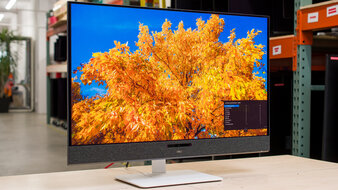




Looking to save on your next monitor? We've got you covered! Check out our Early Black Friday 2025 Deals article to see what's worthwhile this year.
-
Best 120Hz Monitor
 Console Gaming9.4CAD @ 120Hz9.9HDR Picture9.4SDR Picture10Brightness7.2PC Gaming9.1PS5 Compatibility10Xbox Series X|S Compatibility10Size27"Pixel TypeQD-OLEDMax Refresh Rate240 HzSee all our test resultsNative Resolution3840 x 2160
Console Gaming9.4CAD @ 120Hz9.9HDR Picture9.4SDR Picture10Brightness7.2PC Gaming9.1PS5 Compatibility10Xbox Series X|S Compatibility10Size27"Pixel TypeQD-OLEDMax Refresh Rate240 HzSee all our test resultsNative Resolution3840 x 2160The best 120Hz monitor we've tested is the ASUS ROG Swift OLED PG27UCDM. It's an outstanding gaming monitor with premium picture quality and performance. While it has a maximum refresh rate of 240Hz, it's still fantastic to use at 120Hz thanks to its near-instantaneous response time at any refresh rate, which results in almost no motion blur with fast-moving objects. It also has a 4k resolution and HDMI 2.1 bandwidth, so you can play 4k games with the PS5, PS5 Pro, and Xbox Series X|S up to 120Hz.
Its QD-OLED panel even offers outstanding picture quality. It displays deep and inky blacks in dark rooms against bright highlights without any haloing, and it gets bright enough for highlights to pop. Additionally, it displays a wide range of colors in HDR that look extremely vivid and life-like. While its 27-inch screen offers an immersive gaming feel for most gamers, you can also consider the 32-inch ASUS ROG Swift OLED PG32UCDM if you want a larger screen. It performs similarly to the PG27UCDM and has many of the same features, but because of the larger screen, it has lower pixel density, so images aren't as sharp.
-
Best Upper Mid-Range 120Hz Monitor
 Console Gaming9.0CAD @ 120Hz9.9HDR Picture9.3SDR Picture10Brightness6.7PC Gaming8.8PS5 Compatibility10Xbox Series X|S Compatibility8.2Size32"Pixel TypeQD-OLEDMax Refresh Rate120 HzSee all our test resultsNative Resolution3840 x 2160
Console Gaming9.0CAD @ 120Hz9.9HDR Picture9.3SDR Picture10Brightness6.7PC Gaming8.8PS5 Compatibility10Xbox Series X|S Compatibility8.2Size32"Pixel TypeQD-OLEDMax Refresh Rate120 HzSee all our test resultsNative Resolution3840 x 2160If you find the ASUS ROG Swift OLED PG27UCDM too much out of your price range but still want a premium display, look into the lower-end Dell S3225QC. It has a QD-OLED panel and is fairly similar in features and even performance to the higher-end ASUS, with the main difference being that it has a lower 120Hz refresh rate. While this isn't a problem for console gaming at 120Hz, it's something to consider if you also want a monitor for PC gaming on the side. This is a downside for getting this cheaper option, but if you don't need the higher refresh rate, you can save a lot of money by getting the Dell.
Besides that, it has HDMI 2.1 bandwidth to take advantage of gaming consoles, as it supports 4k @ 120Hz signals. Like the ASUS, it has a near-instantaneous response time for sharp motion, it supports all common VRR formats to reduce screen tearing, and it has low input lag for a responsive feel. It also displays the same deep and inky blacks in dark rooms with bright highlights for incredible picture quality. However, it doesn't get as bright as the ASUS, and it's less accurate in HDR.
-
Best Mid-Range 120Hz Monitor
 Console Gaming8.5CAD @ 120Hz7.9HDR Picture6.8SDR Picture7.1Brightness8.7PC Gaming7.7PS5 Compatibility10Xbox Series X|S Compatibility10Size27"Pixel TypeIPSMax Refresh Rate320 HzSee all our test resultsNative Resolution3840 x 2160
Console Gaming8.5CAD @ 120Hz7.9HDR Picture6.8SDR Picture7.1Brightness8.7PC Gaming7.7PS5 Compatibility10Xbox Series X|S Compatibility10Size27"Pixel TypeIPSMax Refresh Rate320 HzSee all our test resultsNative Resolution3840 x 2160If you don't have the budget for premium QD-OLEDs, check out a mid-range option like the Acer Nitro XV275K P5biipruzx. It's different from the ASUS ROG Swift OLED PG27UCDM and the Dell S3225QC in a few ways, with the main downside being that it's a step down in picture quality. It doesn't have a QD-OLED panel like the two previously mentioned monitors, so it doesn't display the same deep and inky blacks in dark rooms. While it has a Mini LED local dimming feature that helps improve the black levels in dark scenes and makes highlights pop, there's haloing around bright objects. You can only use this local dimming feature in HDR, so the picture quality is worse in SDR.
On the plus side, it gets much brighter than the Dell, so it fights glare well in bright rooms. Like the Dell, it also has HDMI 2.1 bandwidth to take full advantage of gaming consoles at 120Hz, including at 4k. While it doesn't have the same near-instantaneous response time as an OLED, motion still looks sharp at 120Hz, but there's inverse ghosting behind fast-moving objects.
-
Best Budget 120Hz Monitor
 Console Gaming7.4CAD @ 120Hz8.5HDR Picture8.0SDR Picture8.2Brightness8.3PC Gaming8.2PS5 Compatibility4.9Xbox Series X|S Compatibility7.1Size27"Pixel TypeVAMax Refresh Rate180 HzSee all our test resultsNative Resolution2560 x 1440
Console Gaming7.4CAD @ 120Hz8.5HDR Picture8.0SDR Picture8.2Brightness8.3PC Gaming8.2PS5 Compatibility4.9Xbox Series X|S Compatibility7.1Size27"Pixel TypeVAMax Refresh Rate180 HzSee all our test resultsNative Resolution2560 x 1440If you want a monitor on a budget, check out the AOC Q27G3XMN, which offers great value as a low-cost display. It has a lower resolution than the Acer Nitro XV275K P5biipruzx, so images aren't as sharp and detailed, and because it lacks HDMI 2.1 bandwidth, it doesn't support 4k @ 120Hz signals from gaming consoles or VRR from a PS5. That said, it still supports 1440p @ 120Hz signals from a PS5 and Xbox Series X|S. While this monitor has Mini LED backlighting like the Acer, the AOC has an advantage in terms of picture quality. You can use its local dimming feature as you wish in SDR and HDR, and it's more effective at improving the picture quality as it has less haloing than the Acer.
In terms of gaming, motion looks sharp for the most part on the AOC, but there's still smearing with fast-moving objects in dark scenes. This isn't as much of a problem if you play slower-paced games. Another option you can check out is the similar AOC Q27G40XMN. It has a better local dimming feature as it gets brighter, but it has worse motion, and it's only available in the US.
-
Best Cheap 120Hz Monitor
 Console Gaming7.3CAD @ 120Hz5.3HDR Picture4.9SDR Picture7.4Brightness7.2PC Gaming6.1PS5 Compatibility10Xbox Series X|S Compatibility8.5Size27"Pixel TypeIPSMax Refresh Rate120 HzSee all our test resultsNative Resolution3840 x 2160
Console Gaming7.3CAD @ 120Hz5.3HDR Picture4.9SDR Picture7.4Brightness7.2PC Gaming6.1PS5 Compatibility10Xbox Series X|S Compatibility8.5Size27"Pixel TypeIPSMax Refresh Rate120 HzSee all our test resultsNative Resolution3840 x 2160If you need a simple and cheap monitor for gaming at 120Hz, look into the Dell S2725QS, which is worth getting when it's on sale. As expected for an entry-level monitor, it has much worse picture quality than the AOC Q27G3XMN. It has a low contrast ratio, and without a local dimming feature, it fails to display deep blacks and make highlights pop for an impactful HDR experience. It also has worse motion handling than the AOC because there's more blur behind fast-moving objects, which is disappointing if you play action games.
However, this monitor has a few advantages over the AOC. It has a higher 4k resolution, so images are more detailed, and it also supports HDMI 2.1 bandwidth to take full advantage of gaming consoles. Although it has a lower refresh rate than the AOC, its 120Hz refresh rate is exactly what you need for console gaming. If you prefer a cheap monitor that's more versatile for PC gaming with a higher refresh rate, you can also check out the LG 24GS65F-B, but it has a lower 1080p resolution and lacks HDMI 2.1 bandwidth.
Notable Mentions
-
Dell Alienware AW2725Q:
The Dell Alienware AW2725Q is a 4k, 240Hz QD-OLED that's a cheaper alternative to the ASUS ROG Swift OLED PG27UCDM. It performs similarly for the most part, but it doesn't get as bright as the ASUS.
See our review -
ASUS ROG Strix OLED XG27ACDNG:
The ASUS ROG Strix OLED XG27ACDNG is in the same price range as the Dell S3225QC. Although it has a QD-OLED panel, it's different than the Dell because it has a lower 1440p resolution and higher 360Hz refresh rate. It's more versatile for PC gaming, too, but images are less detailed.
See our review -
LG 27GR93U-B:
The LG 27GR93U-B is a 4k gaming monitor that you may be able to find for cheaper than the Acer Nitro XV275K P5biipruzx. However, it has worse picture quality than the Acer.
See our review -
ASUS ROG Strix XG27ACS:
The ASUS ROG Strix XG27ACS is an entry-level gaming monitor with better motion handling than the Dell S2725QS. It's something to consider if you play fast-paced games, but it lacks HDMI 2.1 bandwidth and supports less signals from consoles.
See our review
Recent Updates
Dec 01, 2025:
We replaced the ASUS ROG Strix OLED XG27ACDNG and the LG 24GS65F-B with the Dell S3225QC and the Dell S2725QS for consistency with other articles, as they each have a higher resolution. We also replaced the LG 32GR93U-B with the Acer Nitro XV275K P5biipruzx, which has better picture quality. In the Notable Mentions, we removed the Gigabyte AORUS FO27Q3, the MSI G274QPF-QD, and the Samsung Odyssey G70D S32DG70, and added the LG 27GR93U-B, the ASUS ROG Strix XG27ACS, and the XG27ACDNG.
Oct 15, 2025:
We replaced the Acer Nitro XV275K P3biipruzx with the LG 32GR93U-B, which is easier to find. We also replaced the Samsung Odyssey G55C S27CG55 with the LG 24GS65F-B, which is cheaper and has better motion handling. In the Notable Mentions, we replaced the AOC Q7G40XMN and the Gigabyte GS27QC with the MSI G274QPF-QD and the Samsung Odyssey G70D S32DG70.
Jul 08, 2025:
We replaced the MSI MPG 321URX QD-OLED and the MSI MPG 271QRX QD-OLED with the ASUS ROG Swift OLED PG27UCDM and the ASUS ROG Strix OLED XG27ACDNG, respectively, because the MSI monitors are hard to find. We added the Samsung Odyssey G55C S27CG55 as the 'Best Cheap' option. Based on these changes, we also replaced the ASUS ROG Swift OLED PG32UCDM, LG 27GS95QE-B, Dell Alienware AW3225QF, and the XG27ACDNG with the Dell Alienware AW2725Q, AOC Q27G40XMN, and the Gigabyte GS27QC in the Notable Mentions.
Apr 03, 2025:
We removed the LG 27GP850-B/27GP83B-B because it's hard to find. We also replaced the ASUS ROG Strix XG27ACS with the ASUS ROG Strix OLED XG27ACDNG in the Notable Mentions.
Feb 19, 2025:
We replaced the Dell G2724D with the LG 27GP850-B/27GP83B-B because the Dell is hard to find. Also, we introduced a new format to the article and updated the text to reflect these changes.
All Reviews
Our recommendations are based on what we think are the best monitors currently available that you can use at 120Hz, including the best 4k 120Hz monitors. They're adapted to be valid for most people in each price range. The rating is based on our review, factoring in price and feedback from our visitors.
If you'd prefer to make your own decision, here's the list of all the monitors we've tested with a refresh rate of 120Hz or higher. Be careful not to get too caught up in the details. Most monitors are good enough to please most people, and the things we fault monitors on are often not noticeable unless you really look for them.
